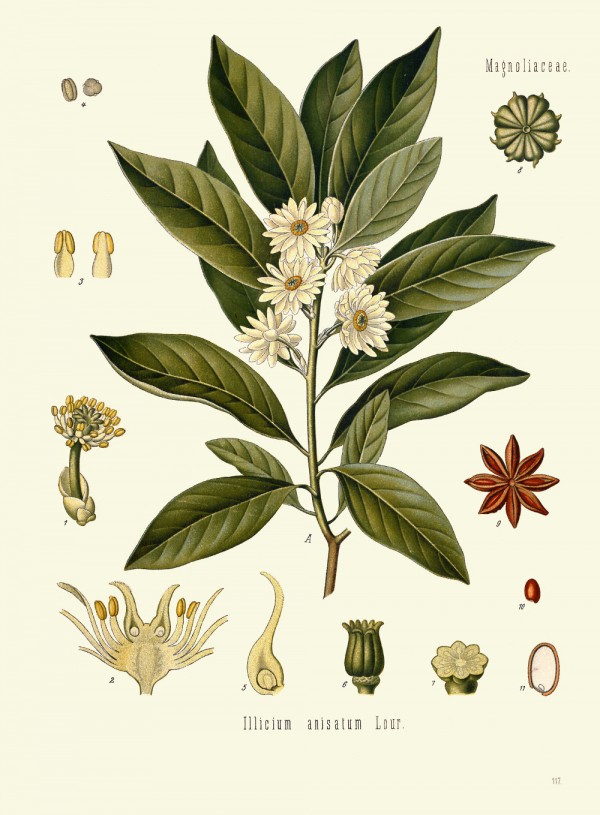Dies ist eine alte Version des Dokuments!
Illicium anisatum L. - syn.Illicium religiosum Siebold & Zucc. - Schisandraceae
シキミ(樒、櫁、梻, shikimi, jap.), Japanese star-anise, aniseedtree, Japanischer Sternanis
Evergreen tree, native to Japan (Honshu : Kantô; Shikoku; Kyushu),, Taiwan, South Korea.
„Since it is highly toxic, it is not edible; instead, it has been burned as incense in Japan, where it is known as shikimi… Shikimi gave its name to shikimic acid, a substance also present in the plant. http://en.wikipedia.org/wiki/Illicium_anisatum
Seeds and carpels of the Japanese star anise contain a convulsant (toxic) principle, anisatin.
[On the Toxin of Illicium Anisatum. I. The Isolation and Characterization of a Convulsant Principle: Anisatin1., Lane, John F., et al., Journal of the American Chemical Society Vol.74(13), 1952, 3211-3215]
„The oil of the Japanese star anise tree, Illiciumanisatum Linn., was analyzed by gas-liquid chromatography. The major constituents were found to be cineole (18.1%), linalool (10.1%), methyleugenol (9.8%), α-terpinyl acetate (6.8%), safrole (6.6%), and a sesquiterpene hydrocarbon of unknown constitution (7.2%). The composition of this oil differs widely from that of the commercially used star anise oil obtained from Illiciumverum Hooker. The most striking difference between the two oils is found in the anethole content, which constitutes 88% of the commercial oil but only 1.2% of the oil here investigated.“
[The essential oil of Illicum anisatum Linn., Cook, W. B., Howard, A. S., Canadian Journal of Chemistry, Vol.44(21), 1966, 2461-2464]
„Four phenolic compounds were isolated from the leaf oil of Illicium anisatum L. Spectroscopic and synthetic studies showed that they were 1-allyl-2-methoxy-4,5-methylenedioxybenzene, 4-allyl-2,6-dimethoxyphenol, 1-allyl-3-methoxy-4-(3-methylbut-2-enyloxy) benzene and 1-allyl-3,5-dimethoxy-4-(3-methylbut-2-enyloxy) benzene.“
[Phenolic components from leaf oil of Illicium anisatum L., Shibuya, M., Abe, K., Nakahashi, Y., Kubota, S., Chem. Pharm. Bull.,(Tokyo), Vol.26, 1978, 2671-2673]
„The neuropharmacological properties of anisatin were tested on the frog spinal cord and the crude synaptic membrane from rat brain… anisatin is a picrotoxin-like, non-competititve GABA-antagonist.“
[Anisatin, a potent GABA antagonist, isolated from Illicium anisatum., Kudo, Y., Oka, J. I., Yamada, K., Neuroscience letters, Vol.25(1), 1981, 83-88]
There are some other anisatin-type sesquiterpenes present in the fruit, like neoanisatin, pseudoanisatin, 2α-hydroxyneoanisatin and 7-deoxy-7β-hydroxypseudoanisatin.
[Two sesquiterpene lactones from Illicium anisatum., Kouno, I., Mori, K., Akiyama, T., Hashimoto, M., Phytochemistry, Vol.30(1), 1991, 351-353]
„Chinese star anise (Illicium verum Hook f.) is a well-known spice used in many cultures. Many populations use it as a treatment for infant colic. Japanese star anise (Illicium anisatum L), however, has been documented to have both neurologic and gastrointestinal toxicities. Recently, concern has been raised regarding the adulteration of Chinese star anise with Japanese star anise. We report 7 cases of adverse neurologic reactions in infants seen with the home administration of star anise tea. In addition, we have found evidence that Chinese star anise has been contaminated with Japanese star anise.“
[Neurotoxicities in infants seen with the consumption of star anise tea., Ize-Ludlow, D., Ragone, S., Bruck, I. S., Bernstein, J. N., Duchowny, M., Peña, B. M. G., Pediatrics, Vol.114(5), 2004, e653-e656]
„The essential oil of air-dried Illicium anisatum (Illiciaceae), obtained by hydrodistillation was analyzed by gas chromatography-mass spectrometry (GC-MS)… Eucalyptol (cineole, 21.8 %), sabinene (5.3 %), α-terpinyl acetate (4.9 %), kaurene (4.5 %), isopimaradiene (3.2 %), safrole (2.7 %), linalool (2.6 %), δ-cadinene (2.2 %), α-cadinol (2.2), and terpinene-4-ol (1.9 %) were the main constituents of the essential oil of I. anisatum. In contrast, the main compounds identified by Cook and Howard were cineole (18.1 %), linalool (10.1 %), methyleugenol (9.8 %), α-terpinyl acetate (6.8 %), and safrole (6.6 %). This difference in the main components may be due to the provenance of the plant, harvest time or development stage, extraction technique, or the use of fresh or dried plant material. All of these factors influence the chemical composition and biological activity.“
[Chemical composition, antioxidant, anti-elastase, and anti-inflammatory activities of Illicium anisatum essential oil., Kim, J. Y., Kim, S. S., Oh, T. H., Baik, J., Song, G., Lee, N., Hyun, C. G., Acta pharmaceutica, Vol.59(3), 2009, 289-300]
„The volatile compounds from the pericarps of Illicium anisatum L., Illicium brevistylum A.C.Sm., Illicium griffithii Hook.f. & Thomson, Illicium henryi Diels, Illicium lanceolatum A.C.Sm., Illicium majus Hook.f. & Thomson, Illicium micranthum Dunn, and Illicium verum Hook.f. were examined by thermal desorption-gas chromatography-mass spectrometry (TD-GC-MS). The volatiles desorbed from the pericarps of I. verum (Chinese star anise), the species traded for culinary purposes, were generally characterized by a high proportion of (E)-anethole (57.6-77.1%) and the presence of foeniculin; the latter was otherwise only detected in the pericarps of I. lanceolatum. In the pericarps of all other species analyzed, the percentage composition of (E)-anethole was comparatively lower (<or=16.0%). The volatiles desorbed from the pericarps of the toxic I. anisatum (Japanese star anise) were characterized by the presence of asaricin, methoxyeugenol, and two other eugenol derivatives, none of which were detected in any of the other species examined.“
[Howes, Melanie-Jayne R., Geoffrey C. Kite, and Monique SJ Simmonds. „Distinguishing chinese star anise from Japanese star anise using thermal desorption− gas chromatography− mass spectrometry.“ Journal of agricultural and food chemistry 57.13 (2009): 5783-5789]

Köhler, F.E., Medizinal Pflanzen, vol.2 t117 (1890)
http://plantgenera.org/species.php?id_species=550586
